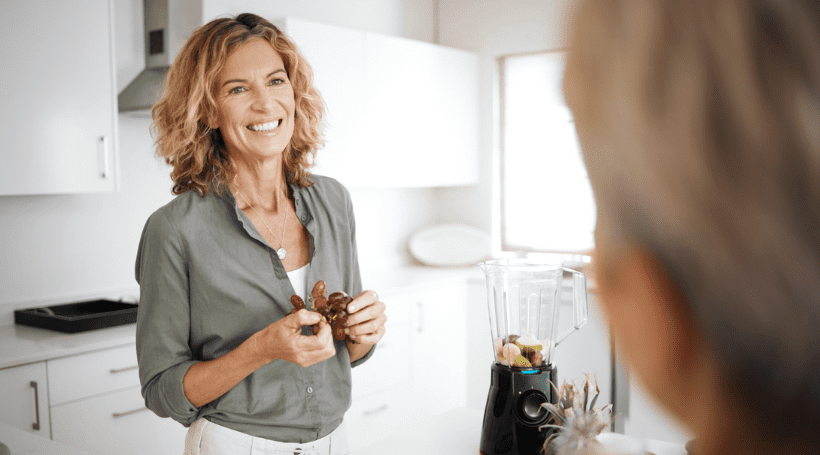We know that the foods we eat can play a role in our risk for breast cancer. If the possibility of getting breast cancer makes you anxious, remember that your diet gives you some control over your risk.
Healthy foods that are high in antioxidants, healthy fats, and dietary fiber can support your breast health, while unhealthy foods can put you at a higher risk for breast cancer.
Let’s look at how a diet rich in antioxidants, omega-3 fatty acids, and fiber can support your breast health, and at how other diet choices can put you at a higher risk for breast cancer.
How antioxidants support your breast health
Antioxidants play a key role in keeping your breast cells healthy and strong, which is important for women who are at higher risk for breast cancer. These powerful substances help your body combat harmful molecules that can damage cells over time. Let’s take a closer look at how antioxidants work, and how you can easily add them to your daily meals.
How do antioxidants protect breast cells?
Antioxidants protect breast cells by neutralizing free radicals, which are unstable molecules that can damage cells, and contribute to cancer development. Free radicals are naturally produced by the body during normal processes like digestion, but they can also come from outside sources, such as pollution and certain foods.
When too many free radicals build up in your body, they can start to damage your cells. Antioxidants help prevent this by stabilizing free radicals before they can harm your breast cells, keeping your breast tissue healthy, and reducing the risk of cancerous changes.
What foods are rich in antioxidants?
Fruits like berries, oranges, and apples are well-known, with blueberries and strawberries being especially rich in antioxidants, as are vegetables like spinach, kale, and bell peppers. Nuts like almonds and walnuts, as well as seeds, are all great options to snack on for an antioxidant boost. Green tea and dark chocolate, in moderation, can even give you beneficial antioxidants.
How can I start including antioxidant-rich foods in my daily diet?
You can start by swapping sugary snacks with fresh fruits like blueberries or an apple. For lunch or dinner, consider adding a side salad with spinach and bell peppers, or sautéing kale with your favorite lean protein. A handful of almonds or walnuts makes for a quick, antioxidant-packed snack. If you’re a tea drinker, switching to green tea can give you an extra dose of antioxidants.
Eating healthy fats to improve your breast health
Incorporating healthy fats into your diet is important for maintaining breast health, especially for women at higher risk for breast cancer. Not all fats are healthy, and choosing the right types can support your overall health, while potentially lowering your cancer risk. Healthy fats, like omega-3 fatty acids, play an important role in maintaining your breast health.
How do omega-3 fatty acids benefit breast health?
Omega-3 fatty acids are known to reduce inflammation in the body. Chronic inflammation can damage cells over time, including breast tissue, which may increase your risk of cancer.
Foods rich in Omega-3s help to counteract this by promoting healthy cell function, and supporting your immune system. Studies have shown that diets rich in omega-3s may lower your risk of developing breast cancer.
What are the best sources of healthy fats like omega-3?
You can find omega-3 fatty acids in a variety of foods, many of which are easy to include in your daily diet. Fatty fish, like salmon, sardines, and mackerel, are some of the best sources of omega-3s. For plant-based options, walnuts, chia seeds, and flaxseeds are also rich in healthy fats.
Other sources of beneficial fats include olive oil, avocados, pecans, macadamia nuts, and hazelnuts, which offer monounsaturated fats that also support breast health. Adding a variety of these foods to your meals can ensure you’re getting a healthy balance of fats.
How can I balance my fat intake?
To make sure you’re getting enough healthy fats, start by replacing unhealthy fats. Try cooking with olive oil instead of butter, or adding avocado to salads and sandwiches, or snacking on a handful of nuts. Set a goal to eat omega-3-rich foods (like fish) at least a couple of times a week, and try to incorporate plant-based sources of healthy fats, as well.

Why fiber is good for your breast health
Fiber is not only important for digestion, but it can also play a significant role in supporting breast health, especially for women who are at risk for breast cancer. A high-fiber diet has been shown to help regulate hormones and support a healthy immune system, both of which are crucial for keeping your breast tissue healthy.
How does fiber help to improve hormonal balance for breast health?
Fiber helps regulate hormones by promoting healthy digestion, and by reducing the amount of circulating estrogen in the body, which is important for breast health. When your estrogen levels are too high, it can increase the risk of breast cancer, as estrogen plays a role in the development of certain types of tumors. Fiber, particularly soluble fiber, binds to excess estrogen in the digestive system and helps remove it from the body.
What kinds of foods are high in fiber?
Whole grains like oats, brown rice, and quinoa are excellent sources of fiber, as are legumes like lentils, chickpeas, and black beans. Fruits like apples, pears, and berries, as well as vegetables like carrots, broccoli, and spinach also provide a good amount of dietary fiber. Nuts and seeds, particularly chia seeds and flaxseeds, are another great way to boost fiber intake.
What can I do to increase my daily fiber intake?
Start by swapping refined grains for whole grains, like using whole wheat bread instead of white, or like choosing brown rice over white rice. Add more legumes to your salads, soups or main dishes, and consider incorporating a serving of fruit with every meal. Snacks like sliced vegetables, nuts, or fiber-rich fruits can help you reach your daily fiber goals. Gradually increasing your fiber intake while drinking plenty of water will help your body adjust while supporting your breast health.
Foods you should think about limiting or avoiding
When it comes to protecting your breast health, certain foods may increase your risk of breast cancer, and other foods are worth limiting or avoiding altogether. Let’s take a close look at how your diet can influence your cancer risk.
How do processed foods and sugar impact my breast-cancer risk?
Many processed foods are high in unhealthy fats, salt and sugar, which can disrupt normal cellular processes and promote an environment where cancer cells are more likely to develop. Diets high in added sugars, like those found in soft drinks, candy, and baked goods, may raise insulin levels and increase estrogen, both of which can fuel the growth of certain breast cancers. By reducing your intake of processed foods and sugary treats, you can help lower these risks.
How does eating red meat and processed meat influence my breast health?
Eating large amounts of red meat and processed meats has been associated with a higher risk of breast cancer. These types of meats often contain preservatives and chemicals that can lead to the formation of cancer-causing compounds in the body.
Cooking methods like grilling or frying red meat at high temperatures can also produce harmful chemicals that may increase cancer risk. Limiting your intake of red and processed meats, and choosing lean proteins like poultry, fish, or plant-based options can help protect your breast health.
How can alcohol consumption influence the likelihood of developing breast cancer?
Even moderate drinking has been linked to a higher likelihood of breast cancer, due to alcohol’s ability to raise estrogen levels and damage DNA in breast cells. The more alcohol you consume, the higher your risk becomes.
For women who are at risk for breast cancer, limiting or avoiding alcohol altogether may be a good preventive measure. If you choose to drink, consider doing so in moderation, and always be mindful of the potential impact on your breast health.
We all have a reason to make our breast health a priority. Find your reason with SJRA.
At South Jersey Radiology, we provide comprehensive breast care services, from 3D mammography screenings to diagnosis.
Our subspecialized breast imaging radiologists read 100,000 mammograms annually and are highly trained to detect subtle irregularities that others might miss.
Easily schedule your mammograms online, 24/7, at any of our convenient locations below:
- Cherry Hill Office – Cherry Hill, NJ
- Haddonfield Office – Haddonfield, NJ
- Marlton (Greentree) Office – Marlton, NJ
- Moorestown Office – Moorestown, NJ
- Turnersville Office – Turnersville, NJ
- West Deptford Office – West Deptford, NJ
- Willingboro Office – Willingboro, NJ
- Women’s Center at Cross Keys – Sewell, NJ
- Women’s Center at Medford – Medford, NJ
- Women’s Center at Mount Laurel – Mount Laurel, NJ









